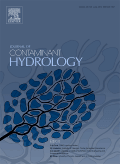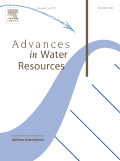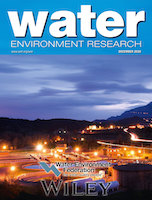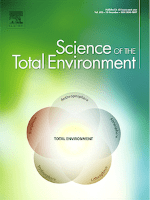
JOURNAL OF CONTAMINANT HYDROLOGY
Scope & Guideline
Advancing knowledge on water quality and pollutant behavior.
Introduction
Aims and Scopes
- Contaminant Transport Mechanisms:
Research on the physical, chemical, and biological processes that govern the movement of contaminants through soil and water systems, including numerical modeling and experimental studies. - Innovative Remediation Technologies:
Exploration of advanced techniques for the remediation of contaminated water and soil, including bioremediation, nanotechnology, and electrokinetic methods. - Hydrogeochemical Characterization:
Analysis of the chemical and physical properties of groundwater and surface water, assessing the effects of anthropogenic activities and natural processes on water quality. - Impact of Emerging Contaminants:
Investigations into the occurrence, fate, and ecological impacts of new and emerging contaminants, such as microplastics and pharmaceuticals, in aquatic environments. - Data-Driven Approaches and AI in Hydrology:
Application of artificial intelligence and machine learning techniques to improve the prediction and management of contaminant transport and water quality.
Trending and Emerging
- Microplastic Pollution:
An increasing number of studies focus on the prevalence, transport, and remediation of microplastics in various environments, highlighting their growing ecological and human health concerns. - AI and Machine Learning Applications:
There is a notable surge in research utilizing artificial intelligence and machine learning to optimize contaminant detection, prediction, and management strategies, indicating a shift towards data-driven methodologies. - Integrated Approaches to Water Quality Management:
Research emphasizing holistic and integrated frameworks for managing water quality, combining ecological, chemical, and socio-economic factors, is gaining prominence in response to complex environmental challenges. - Advanced Remediation Techniques:
Emerging technologies for remediation, including the use of nanomaterials and bioengineering, are increasingly featured, reflecting a shift towards innovative solutions for environmental cleanup. - Climate Change Impact Studies:
Research examining the effects of climate change on contaminant transport and water resources is rapidly expanding, addressing urgent environmental issues faced globally.
Declining or Waning
- Traditional Contaminant Modeling Techniques:
The reliance on conventional modeling approaches has diminished as more sophisticated data-driven and hybrid models emerge, leading to a decline in publications focused solely on traditional methods. - Longitudinal Studies of Established Contaminants:
Research on well-known contaminants such as heavy metals and PAHs is becoming less frequent as attention shifts towards emerging pollutants and innovative remediation strategies. - Basic Hydrogeological Studies:
Publications that focus primarily on fundamental hydrogeological principles without integrating contemporary contaminant studies are less common, reflecting a trend towards more applied and interdisciplinary research.
Similar Journals

Carpathian Journal of Earth and Environmental Sciences
Illuminating the Path to Sustainable Earth PracticesCarpathian Journal of Earth and Environmental Sciences is a distinguished academic journal dedicated to advancing the interdisciplinary field of Earth and environmental sciences. Published by the Carpathian Association for Environment and Earth Sciences, this journal plays a pivotal role in disseminating high-quality research focused on the dynamic interactions between geological processes and environmental changes. With an ISSN of 1842-4090 and an E-ISSN of 1844-489X, the journal is indexed in Scopus and holds an esteemed Q3 quartile ranking in both Earth and Planetary Sciences and Environmental Science categories as of 2023. Since its inception in 2008, the Carpathian Journal has provided an open access platform for researchers, professionals, and students to share insights, foster collaboration, and engage in critical discussions on pressing environmental issues. By continuously contributing to the body of knowledge in this field, the journal not only enhances academic discourse but also promotes sustainable environmental practices across Romania and beyond.

GEOLOGICA ACTA
Connecting scholars, shaping geological innovation.GEOLOGICA ACTA is a distinguished open-access journal dedicated to the field of geology, published by Universitat de Barcelona since its inception in 2003. With an impact factor that reflects its relevance in the academic community and a commendable Q2 ranking within the Earth and Planetary Sciences category, this journal is committed to disseminating high-quality research that spans various aspects of geological sciences. The journal's broad scope encompasses both theoretical and applied research, making it a vital platform for researchers, professionals, and students alike to share their findings with a global audience. With its Open Access policy, GEOLOGICA ACTA ensures that all published articles are freely accessible, fostering collaboration and innovation in the geological community. Based in Barcelona, Spain, at the Geociences Barcelona (CSIC), it plays a pivotal role in connecting scholars from diverse backgrounds and advancing the field of geology through rigorous peer-reviewed articles.

VADOSE ZONE JOURNAL
Exploring innovative methodologies in soil research.Vadose Zone Journal, published by Wiley, is a premier Open Access journal dedicated to advancing research in the dynamic field of soil science, particularly focusing on the vadose zone—the area of soil above the groundwater table that plays a critical role in hydrological processes. Since its inception in 2002, the journal has provided a platform for high-quality, impactful research, reflected in its impressive ranking among the top 25% of journals in the Soil Science category. With an increasing emphasis on sustainable agricultural practices and environmental protection, the Vadose Zone Journal offers invaluable insights and innovative methodologies that cater to the needs of researchers, practitioners, and students alike. Located in Hoboken, NJ, the journal operates on a fully Open Access model since 2018, ensuring that cutting-edge findings are readily accessible to a global audience. Join the community of experts and make significant contributions to our understanding of critical soil processes through this esteemed publication.

ADVANCES IN WATER RESOURCES
Advancing water science for a sustainable future.ADVANCES IN WATER RESOURCES is a premier peer-reviewed journal published by Elsevier Science Ltd, dedicated to advancing the field of water science and technology since its inception in 1977. With an impressive Q1 ranking in the field, this journal provides a vital platform for researchers, professionals, and students to disseminate cutting-edge research that addresses critical issues related to water resources management, hydrology, and environmental sustainability. The journal offers a comprehensive collection of articles that explore innovative methodologies, policy implications, and case studies that shape the future of water resource management. Although it does not provide open access, its impactful contributions are recognized globally, making it an essential resource for anyone engaged in water science. The journal continues to publish relevant research while looking forward to bridging the gap between theoretical insights and practical applications up until 2024.

WATER ENVIRONMENT RESEARCH
Pioneering insights in ecological modeling and environmental chemistry.WATER ENVIRONMENT RESEARCH is a leading scholarly journal dedicated to disseminating cutting-edge research in the fields of water science and technology. Published by WILEY, this esteemed journal (ISSN: 1061-4303; E-ISSN: 1554-7531) is renowned for its rigorous peer-reviewed articles that explore critical issues related to ecological modeling, environmental chemistry, pollution, and waste management. Established in 1992 and continuing through 2024, WATER ENVIRONMENT RESEARCH has secured a notable position within its category quartiles, ranking in the Q2 tier for several disciplines, including ecological modeling and water science and technology. It is highly regarded in the Scopus database, holding a rank of #53 out of 261 journals in Environmental Science related to Water Science and Technology, positioning it in the 79th percentile. As it continues to bridge research and practice, this journal serves as an essential resource for researchers, professionals, and students striving to advance knowledge and foster sustainable solutions within the water environment sector.

JOURNAL OF THE AMERICAN WATER RESOURCES ASSOCIATION
Connecting researchers and practitioners in the vital realm of water resources.The JOURNAL OF THE AMERICAN WATER RESOURCES ASSOCIATION, published by Wiley, is a premier platform dedicated to advancing the field of water resource management and research. With an ISSN of 1093-474X and an impressive Q1 ranking in multiple categories, including Earth-Surface Processes, Ecology, and Water Science and Technology, this journal serves as a vital resource for professionals, researchers, and students alike. Established in 1967 and set to converge through 2024, it has consistently published cutting-edge research that influences policy and practice in water resource management. The journal's open access option enhances its reach, ensuring that critical findings are accessible to a wider audience. The Scopus rankings further underscore its impact, placing it in the top quartile within its fields, highlighting its importance in shaping scholarly discourse. As a significant contributor to the understanding and management of freshwater systems, the journal offers a crucial means for sharing insights and fostering collaboration in the vital realm of water resources.

Environmental Science-Water Research & Technology
Transforming challenges into breakthroughs in water science.Environmental Science-Water Research & Technology is a premier journal published by the Royal Society of Chemistry that focuses on the latest research and technological advancements in the field of water science and engineering. Since its inception in 2015, the journal has steadily gained recognition for its rigorous peer-review process and commitment to advancing our understanding of fresh, wastewater treatment, and sustainable water management. With a remarkable 2023 impact factor and consistently achieving Q1 status in both Environmental Engineering and Water Science and Technology categories, this journal ranks within the top percentile of its field, underscoring its pivotal role in fostering innovative solutions to global water challenges. Currently listed as Rank #26/261 in Water Science and Technology and Rank #34/197 in Environmental Engineering by Scopus, it provides an essential platform for researchers, professionals, and students alike. The journal embraces a broad spectrum of topics concerning water research, aiming to bridge the gap between scientific understanding and practical application.

GEOTECHNIQUE
Advancing the Frontiers of Soil and Rock MechanicsGEOTECHNIQUE is a prestigious peer-reviewed journal published by Emerald Group Publishing Ltd, specializing in the fields of Geotechnical Engineering and Earth and Planetary Sciences. Established in 1948, this journal has consistently delivered groundbreaking research and advancements in the science of soil and rock mechanics, engineering geology, and environmental applications, aiming to foster innovation in geotechnical practices. With an impressive impact factor reflected in its Q1 ranking within both the Earth and Planetary Sciences and Geotechnical Engineering categories, GEOTECHNIQUE is recognized as a leading source of scholarly articles, positioning itself among the top 5% in the field. The journal is accessible via subscription, providing a repository of invaluable insights for researchers, professionals, and students striving to push the boundaries of knowledge and application in geotechnical topics. With a robust editorial board and a commitment to excellence, GEOTECHNIQUE continues to contribute significantly to the academic community and the practical engineering landscape.

Soil and Water Research
Connecting Science and Solutions in Soil and Water ManagementSoil and Water Research, an esteemed journal published by the Czech Academy Agricultural Sciences, is dedicated to advancing the fields of Aquatic Science and Soil Science. With a strong commitment to open access since 2006, this journal facilitates the dissemination of high-quality research and fosters global collaboration among researchers, professionals, and students. Operating from the vibrant academic hub of Prague, Czech Republic, it serves as a key resource for those interested in pressing environmental and agricultural challenges. Featuring a robust H-index and ranking in the Q2 category for both Aquatic Science and Soil Science as of 2023, Soil and Water Research occupies a prominent position in Scopus, ensuring that published works reach a wide audience. The journal invites contributions that explore innovative methodologies and provide insights into soil and water management practices, thus playing a critical role in addressing sustainability issues within these interconnected domains. As researchers navigate the complexities of climate change and resource management, Soil and Water Research stands out as a vital tool for informed decision-making and impactful research.

Science of The Total Environment
Fostering a Deeper Understanding of Our Total EnvironmentScience of The Total Environment, an esteemed journal published by Elsevier, holds a significant position in the field of environmental science, encompassing critical areas such as Environmental Chemistry, Environmental Engineering, Pollution, and Waste Management and Disposal. With an impressive impact factor and ranked in the Q1 quartile across its categories for 2023, the journal is recognized for its high-quality research output and contribution to environmental sustainability. Operating from its base in the Netherlands, the journal has been a valuable resource since its inception in 1972, welcoming innovative studies that address complex environmental challenges. Its notable rankings—such as Rank #9 in both Environmental Sciences and Pollution—underscore its relevance and influence in the academic community. Although the journal currently does not provide an open access option, the robust findings and discussions presented within its pages continue to foster a deeper understanding of environmental issues. Science of The Total Environment is an essential platform for researchers, professionals, and students dedicated to advancing knowledge and solutions in the rapidly evolving field of environmental science.